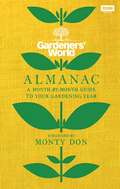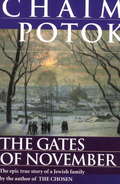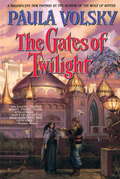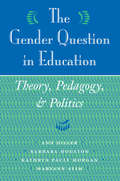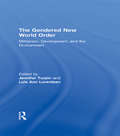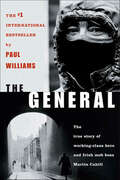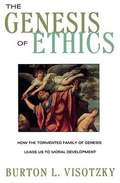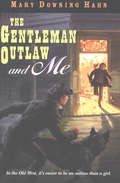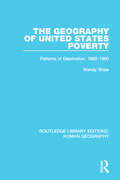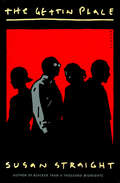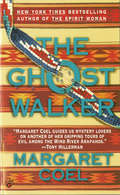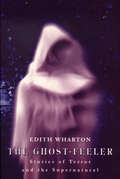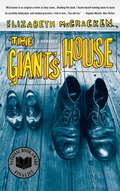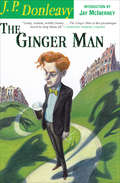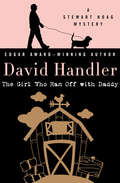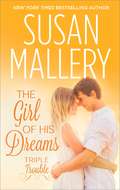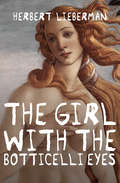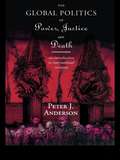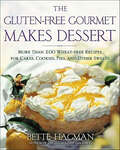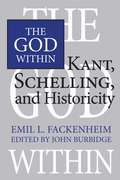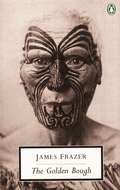- Table View
- List View
The Gardeners’ World Almanac: A month-by-month guide to your gardening year
by Gardeners' World MagazineThe team at Gardeners' World bring you the ultimate guide to your gardening year, from planning and planting to troubleshooting tips and gardening discovery. Organised by month, this book includes lists, timetables, step-by-step guidance and expert advice for year-round gardening, as well as an informative guide on what to plant when and projects for every season. Complemented by beautiful hand-drawn illustrations and tips from your favourite gardening personalities, The Gardeners' World Almanac will help you make your garden look its very best throughout the year.
The Gates of November
by Chaim Potok Vladimir Slepak Alexander Slepak Maria Slepak Leonid Slepak"REMARKABLE . . . A WONDERFUL STORY."--The Boston GlobeThe father is a high-ranking Communist officer, a Jew who survived Stalin's purges. The son is a "refusenik," who risked his life and happiness to protest everything his father held dear. Now, Chaim Potok, beloved author of the award-winning novels The Chosen and My Name is Asher Lev, unfolds the gripping true story of a father, a son, and a conflict that spans Soviet history. Drawing on taped interviews and his harrowing visits to Russia, Potok traces the public and privates lives of the Slepak family: Their passions and ideologies, their struggles to reconcile their identities as Russians and as Jews, their willingness to fight--and die--for diametrically opposed political beliefs."[A] vivid account . . . [Potok] brings a novelist's passion and eye for detail to a gripping story that possesses many of the elements of fiction--except that it's all too true."--San Francisco ChronicleFrom the Trade Paperback edition.
The Gates of Twilight
by Paula VolskyIn a fragile alliance, the natives are stirring uneasily under their foreign rulers. Rebellion is brewing, and at the heart of the conflict lies the bloody and powerful cult of the god Aoun, whose followers will stop at nothing to rid their land of alien domination. So civil servant Renille vo Chaumelle, scion of a proud, conquering line mingled with native blood, is conscripted as a spy and ordered to penetrate the fortress-temple known as the Fastness of the Gods. There he is to discover the secrets of the priests of Aoun and - if the chance presents itself - assassinate the lead priest, named in legend as the god's own son. But in the holiest depths of the temple, Renille finds there is more to the cult than his superiors suspect - far more than they will ever believe. What he learns leads him to the beautiful princess Jathondi, daughter of the native ruler, who is fated to be the crux of a violent confrontation between the fanatic followers of a flesh-hungry god and their arrogant overlords. Together, Jathondi and Renille must brave a whirlwind of revolution and apocalyptic magic that could shatter a nation, and open the long-sealed portal between heaven and earth.
The Gender Question in Education: Theory, Pedagogy, and Politics
by Ann Diller<p>In this innovative book, four prominent philosophers of education introduce readers to the central debates about the role of gender in educational practice, policymaking, and theory. More a record of a continuing conversation than a statement of a fixed point of view, The Gender Question in Education enables students and practicing teachers to think through to their own conclusions and to add their own voices to the conversation. <p>Throughout, the authors emphasize the value of a gender-sensitive perspective on educational issues and the relevance of an ethics of care for educational practice. Among the topics discussed are feminist pedagogy, gender freedom in public education, androgyny, sex education, multiculturalism, the inclusive curriculum, and the educational significance of an ethics of care. <p>The multiauthor, dialogic structure of this book provides unusual breadth and cohesiveness as well as a forum for the exchange of ideas, making it both an ideal introduction to gender analysis in education and a model for more advanced students of gender issues.
The Gendered New World Order: Militarism, Development, and the Environment
by Lois Ann Lorentzen Jennifer TurpinEcological security seems increasingly precarious and battles over land and models of economic development now lead to military conflicts. The Gendered New World Order addresses the compelling issue of how gender connects the global problems of militarism, underdevelopment, and environmental decay. Scholars from around the world make connections between seemingly disparate issues such as refugees, polluted waters, bombed vilages, massive dam projects, starving children, deforestation, nuclear arms buildup and the rights of women.
The General: The True Story of Working-Class Hero and Irish Mob Boss Martin Cahill
by Paul WilliamsIn a twenty-year career marked by obsessive secrecy, brutality, and meticulous planning, Martin Cahill, a k a, The General, netted over 40 million pounds. His criminal record included assassination, kidnapping, bombings, and one of the world's largest art and gold heists! He was untouchable and fiercely loyal to his gang. Loved by the common man, his personal battle with the police made him a living legend. But Martin Cahill not only refused to respect the police, he refused to pay tribute to the IRA. And unlike the police who had to follow the letter of the law in their battle to bring down Ireland's most wanted, the IRA played by their own rules.At the Publisher's request, this title is being sold without Digital Rights Management Software (DRM) applied.
The Genesis of Ethics
by Burton L. VisotzkyBurton L. Visotzky, one of America's most respected scholars of religion, guides readers through a close reading of the narratives of the Book of Genesis, exposing their brutal power and revealing how their moral dilemmas apply to ethical issues we face in our lives today. Rabbi Visotzky has led highly regarded seminars, attended by novelists, poets, editors, filmmakers and critics, Fortune 500 CEOs, bankers, and attorneys. He also was a major participant in Bill Moyers' PBS Genesis series. His reading of Genesis opens the door to moral development for all readers--Christians, Jews, Muslims, and secularists. As Burton Visotzky says, the Book of Genesis seems to be, at least on first reading, "an ugly little soap opera about a dysfunctional family . . . a story about rape, incest, murder, deception, brute force, sex, and blood lust. But these stories reveal much about human dilemmas and ethical problems that mirror our own lives. By delving into the lives of Abraham, Sarah, Isaac, and Esau and holding up these characters of Scripture to the light of critical inquiry, Burton Visotzky reveals much that is fresh and useful about ethics and morality. "He is a rabbi who is earthy, playful, and full of insight, who refuses to draw a veil over the dark side of the Bible or of our own contemporary experience. " --Thomas Cahill, author of How the Irish Saved Civilization "[Visotzky] has a wonderfully earthy, human touch to his commentary, a perspective that can be especially refreshing for Christians who have seen the 'Old Testament' sanitized or ignored by their own tradition. " --San Francisco Chronicle "Thrilling original insights . . . a new way to see and feel these old, old sentences. " --The New York Times Magazine "Visotzky delights in turning the gem of each story so that its facets, especially the darkest ones, gleam out at us. . . . The Genesis of Ethics is a unique contribution to Bible discussion. . . . One can only applaud and thank him. " --Naomi Rosen, Congress Monthly
The Genre of Acts and Collected Biography
by Sean A. AdamsIt is widely accepted by New Testament scholars that the Gospel of Luke and the Acts of the Apostles probably originated as two parts of one work by a single author. In spite of this, the books have been assigned to very different genres: Luke is traditionally viewed as a biography of Jesus, and Acts as a history of the early church. Comparing in detail the structure and content of Acts with the formal features of history, novel, epic and biography, Sean Adams challenges this division. Applying both ancient and modern genre theory, he argues that the best genre parallel for the Acts of the Apostles is in fact collected biography. Offering a nuanced and sophisticated understanding of genre theory, along with an insightful argument regarding the composition and purpose of Acts, this book will be of interest to those studying the New Testament, Acts, genre theory and ancient literature.
The Gentleman Outlaw and Me
by Mary Downing HahnA &“ripsnorting western . . . With plenty of twists and turns—and a cameo appearance by Doc Holliday—it&’s a real cowgirl triumph&” (Kirkus Reviews). In 1887, twelve-year-old Eliza Yates—disguised as a boy—sets out with her faithful dog Caesar to search for her missing father. Along the way, she falls in with gentleman outlaw Calvin Featherbone. &“Together, they make their way to Tinville, Colorado, where, coincidentally, Calvin&’s father was killed by a certain Sheriff Yates. Calvin plans to avenge the murder, but he gets himself and Eliza in so much trouble with his amateurish schemes that the pair arrives in town ready to be hanged as horse thieves. Hahn&’s writing crackles like gunshot in the Ol&’ West, and Eliza and Calvin make a lovable team. The plotting is . . . tight and fast paced, and Hahn does a fine job of recreating the atmosphere of the days of cowboys and miners&” (Booklist). &“Hahn has obviously done her research, and succeeds in bringing the ambiance of the Old West to her novel. The result is a fast, funny, and entertaining adventure that&’s just the thing for fans of Dr. Quinn, Medicine Woman.&”—School Library Journal &“An amusing comedy of errors that derives much of its humor from Calvin&’s speech and manners and Eliza&’s wry asides alluding to her true identity as a girl.&”—Kirkus Reviews
The Geography of Manitoba: Its Land and its People
by Christoph Stadel John Welsted John EverittManitoba is more than one of Canada's three prairie provinces. Encompassing 649,950 square kilometres, its territory ranges from Canadian Shield to grassland, parkland, and subarctic tundra. Its physical geography has been shaped by ice-age glaciers, while its human geography reflects the influences of its various inhabitants, from the First Nations who began arriving over 9,000 years ago, to its most recent immigrants. This fascinating range of geographical elements has given Manitoba a distinct identity and makes it a unique area for study. Geography of Manitoba is the first comprehensive guide to all aspects of the human and physical geography of this unique province. Representing the work of 47 scholars, and illustrated with over 200 maps, diagrams, and photographs, it is divided into four main sections, covering the major areas of the province's geography: Physical Background; People and Settlements; Resources and Industry; and Recreation.As well as studying historical developments, the contributors to Geography of Manitoba analyse recent political and economic events in the province, including the effect of federal and provincial elections and international trade agreements. They also comment on future prospects for the province, considering areas as diverse as resource management and climatic trends.
The Geography of United States Poverty: Patterns of Deprivation, 1980-1990 (Routledge Library Editions: Human Geography #17)
by Wendy ShawUntil this book was originally published in 1996 there had been little detailed research concerning the geographic location of the poor in America. The book examines the spatial distribution of the poor within the US and discusses the general characteristics of the poverty population. It explores the complex web of theory pertaining to poverty, presenting different categories: no fault theories, individual responsibility theories, societal responsibility theories, governemntal and institutional responsibility theories, and responsibility of the economic system theories. Information on poverty from the 1980s and 90s in the US is provided, as well as historical background. The problems and complexities associated with defining and measuring poverty are also discussed.
The Gettin' Place
by Susan StraightIn the third novel by the author of Blacker Than a Thousand Midnights, the Thompson clan tries to deal with the chaos after their family patriarch finds the burning bodies of two white women on his property and is then accidentally gunned down by police.
The Ghost Walker
by Margaret CoelFather John O'Malley comes across the corpse lying in a ditch beside the highway. When he returns with the police, it is gone. The Arapahos of the Wind River Reservation speak of Ghost Walkers--tormented souls caught between the earth and the spirit world, who are capable of anything. Then, within days, a young man disappears from the Reservation without a trace. A young woman is found brutally murdered. And as Father John and Arapaho lawyer Vicky Holden investigate these crimes, someone--or something--begins following them. Together, Vicky and Father John must draw upon ancient Arapaho traditions to stop a killer, explain the inexplicable, and put a ghost to rest...
The Ghost Walker
by Margaret CoelFather John O'Malley comes across the corpse lying in a ditch beside the highway. When he returns with the police, it is gone. The Arapahos of the Wind River Reservation speak of Ghost Walkers-tormented souls caught between the earth and the spirit world, who are capable of anything.Then, within days, a young man disappears from the Reservation without a trace. A young woman is found brutally murdered. And as Father John and Arapaho lawyer Vicky Holden investigate these crimes, someone-or something-begins following them.Together, Vicky and Father John must draw upon ancient Arapaho traditions to stop a killer, explain the inexplicable, and put a ghost to rest...
The Ghost-Feeler: Stories of Terror and the Supernatural
by Edith WhartonDiagnosed with typhoid fever at age of nine, Edith Wharton was beginning a long convalescence when she was given a book of ghost tales to read. Not only setting back her recovery, this reading opened up her fevered imagination to "a world haunted by formless horrors." So chronic was this paranoia that she was unable to sleep in a room with any book containing a ghost story. She was even moved to burn such volumes. These fears persisted until her late twenties. She outgrew them but retained a heightened or "celtic" (her term) sense of the supernatural. Wharton considered herself not "a ghost-seer"--the term applied to those people who have claimed to have witnessed apparitions--but rather a "ghost-feeler," someone who senses what cannot be seen. This experience and ability enabled Edith Wharton to write chilling tales that objectify this sense of unease. Far removed from the comfort and urbane elegance associated with the author's famous novels, the stories in this volume deal with vampirism, isolation, and hallucination, and were praised by Henry James, L. P. Hartley, Graham Greene, and many others.
The Giant's House: A Romance
by Elizabeth MccrackenThe year is 1950, and in a small town on Cape Cod twenty-six-year-old librarian Peggy Cort feels like love and life have stood her up. Until the day James Carlson Sweatt-the "over-tall" eleven-year-old boy who's the talk of the town-walks into her library and changes her life forever. Two misfits whose lonely paths cross at the circulation desk, Peggy and James are odd candidates for friendship, but nevertheless they soon find their lives entwined in ways that neither one could have predicted. In James, Peggy discovers the one person who's ever really understood her, and as he grows-six foot five at age twelve, then seven feet, then eight-so does her heart and their most singular romance.
The Ginger Man
by J. P. Donleavy Jay McInerneyFirst published in Paris in 1955, and originally banned in the United States, J. P. Donleavy’s first novel is now recognized the world over as a masterpiece and a modern classic of the highest order. Set in Ireland just after World War II, The Ginger Man is J. P. Donleavy’s wildly funny, picaresque classic novel of the misadventures of Sebastian Dangerfield, a young American ne’er-do-well studying at Trinity College in Dublin. He barely has time for his studies and avoids bill collectors, makes love to almost anything in a skirt, and tries to survive without having to descend into the bottomless pit of steady work. Dangerfield’s appetite for women, liquor, and general roguishness is insatiable-and he satisfies it with endless charm.
The Girl Who Ran Off with Daddy (The Stewart Hoag Mysteries #7)
by David HandlerA scandal-plagued author is killed in a mystery with &“domestic repartee worthy of Nick and Nora Charles [and a] thoroughly entertaining cast of characters&” (Publishers Weekly). Stewart Hoag has quit ghostwriting. Living in Connecticut with his ex-wife, Hoagy works on a novel and tends to Tracy, his brand-new daughter, who&’s more beautiful than anything he&’s ever written and only took nine months to make. Life is peaceful, until Thor Gibbs arrives to tear it apart. An unapologetically swaggering author, Thor is past seventy but still looks like the brash young man who befriended an aging Hemingway and inspired the first of the Beat poets. Once he was Hoagy&’s mentor, but now he needs his help. Thor is in the middle of a tryst with his eighteen-year-old stepdaughter, and every newspaper, lawyer, and cop in the country wants him strung up from the highest tree. He hires Hoagy to help the beautiful young woman tell their side of the story. But trouble is following the controversial couple, and death is about to visit the cottage. This edition includes AJ Finn&’s introductory essay, &“It&’s Time to Discover Your New Sophisticated Sleuth Obsession: Stewart Hoag.&”
The Girl of His Dreams
by Susan MalleryKayla Bedford had lofty visions of running off to Paris and marrying the prince of her dreams. But before she left, she needed to find a significant other for her conservative boss and best friend, Patrick Walcott.... And who better than her older-by twelve minutes-identical sister? Kayla was sure they'd get along famously. But as the seconds ticked down for her sister's big date with Patrick, a wave of jealously washed over Kayla. Suddenly it seemed her Prince Charming had been right beside her all along. But how was she going to convince Patrick that SHE was the girl of HIS dreams?
The Girl with the Botticelli Eyes
by Herbert LiebermanWhen a madman begins using the work of Botticelli as inspiration for his gruesome tableaus, a New York museum curator is the only man who can stop himMike Manship is an up-and-coming curator at the Metropolitan Museum of Art in New York City. With a Botticelli retrospective fast approaching, Manship is poised to become the Met&’s director if he can secure three final drawings from Italy. Standing in his way is Ludovico Borghini, a neo-fascist count with a fanatical devotion to his Italian heritage and a deadly obsession with the Renaissance master&’s work. Between them are the three masterpieces and the alluring Isobel Cattaneo, a direct descendant of Botticelli&’s greatest muse, Simonetta.Borghini is determined to maintain possession of the drawings, and in the grips of his mania, he kidnaps Cattaneo, whom he suspects of aiding Manship. As the search for Cattaneo reaches a fever pitch, Manship discovers that Borghini is a much more twisted nemesis than he could ever have anticipated—one whose depravity reaches chilling depths.
The Global Politics of Power, Justice and Death: An Introduction to International Relations
by Peter AndersonThis exciting new text adopts a challenging question-led approach to the major issues facing global society today, in order to investigate the nature and complexity of global change. Among other things it looks at the future of the state, the environment, the international political economy, war and global rivalries, and the role of international law and the UN in the post-Cold War world. The book devises a readily comprehensible "change map", which both incorporates a wide range of the fundamental concepts of international relations theory and suggests a number of new concepts capable of assisting the investigation of global change. This new framework is deployed to look closely at real world issues in order to isolate the crucial factors which determine whether or not mass hunger, for example, or enviromental abuse, can be eliminated.
The Gluten-free Gourmet Makes Dessert: More Than 200 Wheat-free Recipes for Cakes, Cookies, Pies, and Other Sweets
by Bette HagmanFrom the leading expert in gluten-free cooking, a new book with more than two hundred recipes for delicious cakes, cookies, pies, and other desserts.Bette Hagman's four cookbooks have sold more than 220,000 copies and established her as the leading expert in the ever growing market of gluten-free cooking. She is the premier creator of recipes for those intolerant to gluten and for those allergic to wheat. In the latest addition to the Gluten-free Gourmet series, Hagman turns her hand to that most loved part of the meal, dessert. At the core of this book are more than two hundred easy-to-follow recipes for delicious cakes, pies, cookies, puddings, and other sweets, including Chocolate Peanuty Cupcakes, Raspberry Bars, and Gingersnaps. The nutritional information and dietary exchanges that accompany each recipe will make these desserts fit easily into any diet. Hagman also answers common questions about gluten-free baking and provides a list of sources for gluten-free baking products you can order by mail. With The Gluten-free Gourmet Makes Dessert no meal will have to end without dessert again.Also Available:The Gluten-free Gourmet, Revised Edition0-8050-6484-2 o $18.00/$27.00 CANMore from the Gluten-free Gourmet0-8050-6524-5 o $18.00/$27.00 CANThe Gluten-free Gourmet Cooks Fast and Healthy0-8050-6525-3 o $18.00/$27.00 CANThe Gluten-free Gourmet Bakes Bread0-8050-6078-2 o $18.00/$27.00 CAN
The Gnostic New Age: How a Countercultural Spirituality Revolutionized Religion from Antiquity to Today
by April D DeconickGnosticism is a heretical tradition that revolutionized the practice of Christianity. Before Gnosticism emerged in the second century, passage to the afterlife required obedience to God and king. Gnosticism proposed that human beings were manifestations of the divine, unsettling the hierarchical foundations of the ancient world. Subversive and revolutionary, Gnostics taught that prayer and mediation could bring human beings into an ecstatic spiritual union with a transcendent deity. This mystical strain affected not just Christianity but many other religions, and it characterizes our understanding of the purpose and meaning of religion today.In The Gnostic New Age, April D. DeConick recovers this vibrant, underground history to prove that Gnosticism was not suppressed or defeated by the Catholic Church long ago, nor was the movement a fabrication to justify the violent repression of alternative forms of Christianity. Gnosticism alleviated existential suffering for millions, soothing feelings of brokenness and alienation through the promise of renewal as God. DeConick begins in ancient Egypt and follows with the rise of Gnosticism in the Middle Ages, the advent of theosophy and other occult movements in the Victorian era and early twentieth century, and contemporary New Age spiritual philosophies. As these theories find expression in science-fiction and fantasy films, DeConick sees evidence of Gnosticism's next incarnation. Her work emphasizes the universal, countercultural appeal of a movement that embodies much more than a simple challenge to religious authority.
The God Within: Kant, Schelling, and Historicity (The Royal Society of Canada Special Publications)
by John W. Burbidge Emil FackenheimFor nineteenth-century thinkers, the central problem of religious consciousness in the modern West was the tension between prevailing concepts of individual autonomy and the traditional Judaeo-Christian claim for divine revelation. The God Within brings together ten of Professor Emil Fackenheim's essays on the German Idealists who struggled to resolve this tension. This philosophic preoccupation found its most searching and comprehensive expression, when the traditional notion of 'God as Transcendent' was reconceptualized as 'the God within.' The internalization of God's `otherness' reached its climax with Hegel, the subject of Fackenheim's earlier work, The Religious Dimension in Hegel's Thought. This long-awaited companion to that volume examines the earlier stages of the process, beginning with its initiator, Kant, then considering Schelling in both his earlier and later phases, and finally, looking once more at Hegel. The investigation of this movement, together with the related themes of history and the literary arts, leads to reflection on the significance of taking historicity seriously. Included is the classic, much-cited article `Metaphysics and Historicity,' which connects the philosophy of German Idealists to twentieth-century questions of historicity and existential thought in particular. The previously unpublished essay `Schelling in 1800-1801: Art as Revelation,' provides an overview of philosophical history from Kant through Fichte and Schleiermacher, to the later Schelling. All the essays gathered here are concerned with the radical singularity of history and existence on the one hand and the demands of philosophical truth on the other. They are informed by Professor Fackenheim's engagement with the profound philosophical challenges of our day--particularly his efforts, as a Jewish theologian, to confront the horrors of the Holocaust. We see, through Fackenheim's exposition, how these thinkers sought to come to terms with the presence of radical evil, a problem whose modern relevance is explored in this volume's epilogue, the 1988 essay `Holocaust and Weltanschauung: Philosophical Reflections on Why They Did It.'
The Golden Bough (Penguin Modern Classics)
by Sir James FrazerSir James George Frazer (1854-1941) caught the popular imagination with his vast and enterprising comparative study of the beliefs and institutions of mankind, which in its third edition numbered 12 volumes. Reissued here is Frazer's own single-volume abridgement of 1922.
